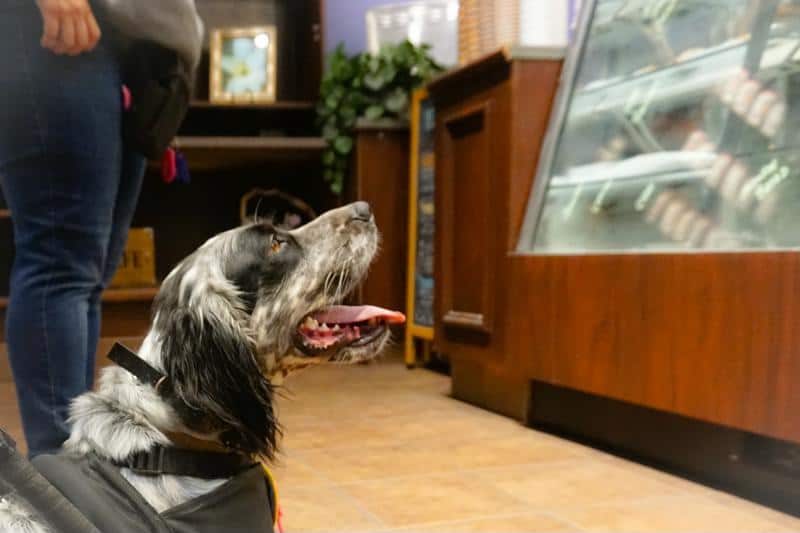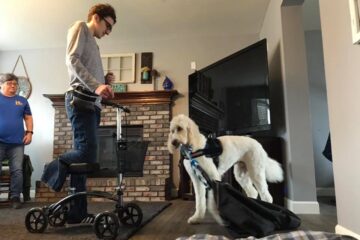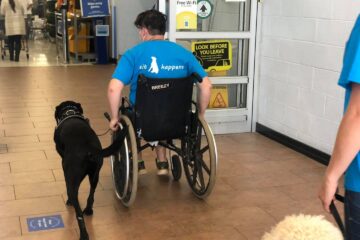“What do service dogs even do?”
That seems to be the burning question on most people’s minds when they see a service dog. To most, the answer makes perfect sense. It’s easy – service dogs perform tasks for their handlers to make daily life easier, and, in some cases, to make it manageable.
But sometimes, it seems the answer only raises more questions.
“What does that mean? How? How can a service dog really change someone’s life that much?”
The answer to those questions lies in the life-changing tasks that service dogs perform.
In this article, we’ll explore the different tasks a service dog can be trained to perform.
Mobility service dogs
A mobility service dog can help to perform tasks to help those who have difficulty moving. These tasks include:
● Retrieving dropped items
● Retrieving specific items
● Opening/closing doors (fridge, cabinet, etc)
● Turning a light switch on/off
● Bracing/balance
Every single one of these tasks is something that most of us do on a daily basis without a second thought. We drop our phones, pencils, and various other items all the time – but it’s barely a problem, because we can pick it right back up without much effort at all.
For a disabled person, bound to a wheelchair, picking up that item is nearly impossible without some form of assistance. With a service dog who knows how to retrieve anything that hits the floor, that impossibility becomes a possibility – a well-trained mobility service dog can perform so many different tasks for their handlers.

For most people, needing something from another room is a breeze. We open doors, turn on lights, and get what we need in no time at all.
In a wheelchair, just navigating the house becomes an obstacle course. Opening the bedroom door is difficult, annoying, and takes a lot of maneuvering. Simply turning on the light is a stretch, with quite a bit of careful positioning needed to be able to get within range. Then, at long last, the door is open and the room is lit, yet the desired object is in the middle of the bed – but it is too far to reach.
A trained mobility service dog can retrieve that item for the handler with far less struggle. With so many doors, switches, and other obstacles present in the world, having a service dog can often be the difference between leaving the house or staying home all the time.
Seizure alert & seizure response dogs
Seizure alert and response dogs are a lifesaving tool for individuals who regularly suffer from seizures – and in the case of children, can provide peace of mind to parents. Some of the tasks these dogs can provide include:
- Bark/paw/custom alert for a seizure
- Retrieving a medicine bag
- Assistance getting up or walking
- Pressing a medical alert button
- Clearing airway during asphyxiation

Service dogs are a life-saving tool for seizure alerts/responses. When it comes to children who have seizures, parents are in a constant state of tension. There are so many variables – what if they leave the room for too long? What if their child has a seizure in the middle of the night?
With no way to know when a seizure might happen, and no way to know if one is occuring unless they’re in the same room, life is a huge knot of stress and worry. Everyone is always on edge, hoping they’ll be there during a seizure to make sure their child is safe.
A seizure alert dog can put an entire family at ease, knowing that the dog will alert them if their child or loved one has a seizure.
For adults, either living on their own or with a family who isn’t around 24/7, a seizure response dog can be invaluable. Sometimes, during a seizure, people will vomit. This is extremely dangerous because if no one is around, that person could choke.
A service dog can be taught to clear the mouth and airway to prevent suffocation in these circumstances. In addition to clearing the airway, the dog can be taught to press a medical emergency button to call an ambulance in the event that the handler lives alone.
Hearing assistance dogs
For those who are hard of hearing, a hearing assistance dog can be an invaluable asset. They can perform tasks such as:
● Paw/jumping on handler
● Going to the source of the sound and then back to the handler over and over
Not being able to hear certain sounds can be dangerous. A deaf person may not even know a fire is in the same building as them because they are unable to hear the fire alarm.
Service dogs can be taught to jump up on their handler when they hear a fire alarm and other urgent sounds, or they can be taught to lead the handler to the source of a sound (such as the fire alarm, doorbell, etc).

Autism service dogs
Finally, autism assistance dogs perform a number of tasks which help calm their handler or provide reassurance if a handler becomes overwhelmed. These tasks include:
● Deep pressure therapy
● Nudge/paw
● Tethering
● Emergency down
● Trailing
Autism affects a lot of aspects in a child’s life, as well as the child’s family. Because autistic kids process their environment much differently than others, they can easily become overwhelmed or confused by the world around them.
Autism service dogs can help families in a number of ways. Deep pressure therapy can help ease a meltdown and reduce anxiety or overstimulation. Often, when autistic children become overwhelmed, having a dog nudge or paw at them can help them focus on just one thing instead of a whole world of things.

The service dog becomes a point of grounding for the child to rely on when things are too much. Sometimes, autistic children will wander off or run away, making it very difficult for parents to take them into stores or public areas for fear of losing their child.
The ability to tether the child to the dog not only gives the child a little more freedom, but also keeps the parent’s mind at ease because their child cannot slip away as easily. However, in the event that the child does run away, still tethered to the dog, the autism assistance dog can respond to an emergency down command, which means the dog will drop into a down, whether the child is still running or wandering away or not. Due to the tether, the dog will stop the child by laying down and staying in place until the parents can catch up and regain control.
With a child who runs away often, or wanders away and gets lost easily, there is also search and rescue trailing, where the dog will follow the odor trail of the child to find them, no matter where they ran. This gives the parents a real sense of safety, knowing there are so many safety measures in place to reduce the risk of having their child run away, but also, if they do, hope is not lost.

In addition to all of the tasks above, an autism assistance dog helps autistic kids connect more with the people around them. They have a source of confidence, a conversation topic, and a responsibility that belongs to them. That sense of responsibility can help ground many kids.
All in all, these are just a few of the tasks that a service dog can perform. There is no limit to what you can teach a service dog to do, and there is no limit to the marvelous effect they have on the lives of their handlers. Hopefully by now, the simple answer from the beginning makes a little more sense.
What do service dogs do?
They change lives.



0 Comments